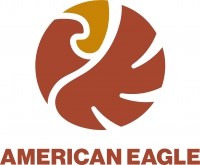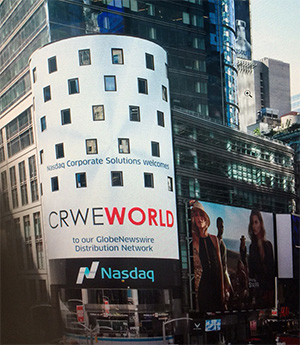American Eagle Intersects Series of Strong Holes Including 77 m of 1.78% CuEq; South Zone Expansion Confirms Continuity from Surface to Depth
October 07, 2025 6:00 AM EDT | Source: American Eagle Gold Corp.
Toronto, Ontario--(Newsfile Corp. - October 7, 2025) - American Eagle Gold Corp. (TSXV: AE) ("American Eagle" or the "Company") is pleased to report a series of broad high-grade intercepts in drilling, including the highest-grade intercepts to date at the NAK copper-gold porphyry project in British Columbia.
Highlights:
Record Intersections: Hole NAK25-48 intersected 77 m of 1.78% Copper Equivalent ("CuEq") within 140 m of 1.23% CuEq, all within 813 m of 0.41% CuEq from surface. Copper alone in the 77 m interval graded 1.21%.
Near-Surface Mineralization: Hole NAK25-49 intersected 115 m of 0.93% CuEq within 454 m of 0.45% CuEq from Surface.
High-Grade Continuity: Holes NAK25-46, together with NAK-48 and -49, confirmed continuity of high-grade mineralization at depth, intersecting 482 m of 0.51% CuEq and bottoming in 96 m of 0.9% CuEq, 100-300 m directly below the best mineralization in hole NAK25-49, and 100-150 m west of that seen in NAK25-48.
South Zone Expanded: The recent drilling extends the zone 200 m south, at least 250 m east, and over 800 m deep, and it remains open for expansion.
South Zone Significance
Drilling earlier this season has greatly expanded the South Zone, primarily to the south and west, with additional drilling expanding it still farther south, as well as to the east.
The broad high-grade intercept in drill hole NAK25-46, which is located 170 metres east of hole NAK25-41, adds breadth and depth to the high-grade and moderate-depth mineralization intersected in both that hole and in holes to the north such as NAK23-08, -10, -11, -17 and NAK24-31. With the improved continuity recently established between the mineralization in those holes and the near surface high-grade mineralization in the historical South Zone by drill hole NAK25-42, this greatly increases the extent of mineralization in the greater South Zone area. NAK25-48, drilled in response to the visually compelling mineralization encountered in NAK25-46 and NAK25-44, further expands this new high-grade sub-zone to depth and to the east, with the strongest copper grades yet encountered on the NAK property.
NAK25-46 and NAK25-48, along with recently assayed hole NAK25-41 (see News Release, July 23, 2025) clearly reinforces the zone's strong potential. Together, NAK25-46 and -48 extend higher-grade mineralization approximately 200 meters farther south and the higher-grade mineralized intercept from NAK25-41 almost 250 meters farther east, where it remains open along an emerging east-west trend. Mineralization occurs within both stratified (largely sedimentary), and well-mineralized intrusive units, with grade closely linked to widespread porphyry-style quartz-chalcopyrite ± bornite veining, associated disseminated chalcopyrite and local bornite and molybdenite, and locally overprinted by late epithermal-style veining.
"The latest drill results at NAK underscore the exceptional potential of this large-scale copper-gold system," said Anthony Moreau, CEO. "High-grade mineralization extends to depth and shows an emerging continuity with surface zones, confirming the value of our discovery. We remain focused on advancing this promising asset to unlock its full potential for our shareholders."
Multimedia Pertaining to News Release:
NAK25-48 Assay Results* (Table 1):
| Hole | From (m) | To (m) | Length (m) | Cu % | Au g/t | Ag g/t | Mo ppm | CuEq % |
| NAK25-48 | 712 | 789 | 77 | 1.21 | 0.3 | 13 | 345 | 1.78 |
| within | ||||||||
| NAK25-48 | 684 | 824 | 140 | 0.81 | 0.23 | 7.7 | 259 | 1.23 |
| within | ||||||||
| NAK25-48 | 439 | 824 | 385 | 0.4 | 0.14 | 3.1 | 130 | 0.62 |
| within | ||||||||
| NAK25-48 | 10 | 824 | 814 | 0.25 | 0.12 | 1.7 | 93 | 0.41 |
| Including | ||||||||
| NAK25-48 | 10 | 162 | 152 | 0.17 | 0.18 | 0.7 | 18 | 0.33 |
NAK25-49 Assay Results* (Table 2):
| Hole | From (m) | To (m) | Length (m) | Cu % | Au g/t | Ag g/t | Mo ppm | CuEq % |
| NAK25-49 | 319 | 434 | 115 | 0.39% | 0.24 | 1.3 | 519 | 0.93% |
| within | ||||||||
| NAK25-49 | 212 | 467 | 255 | 0.32% | 0.18 | 1.2 | 356 | 0.70% |
| within | ||||||||
| NAK25-49 | 13 | 467 | 454 | 0.21% | 0.11 | 0.9 | 220 | 0.45% |
NAK25-46 Assay Results* (Table 3):
| Hole | From (m) | To (m) | Length (m) | Cu % | Au g/t | Ag g/t | Mo ppm | CuEq % |
| NAK25-46 | 781 | 877 | 97 | 0.58 | 0.28 | 3.7 | 115 | 0.89 |
| within | ||||||||
| NAK25-46 | 719 | 877 | 158 | 0.42 | 0.2 | 2.5 | 102 | 0.66 |
| within | ||||||||
| NAK25-46 | 395 | 877 | 482 | 0.28 | 0.21 | 1.4 | 96 | 0.51 |
| within | ||||||||
| NAK25-46 | 33 | 877 | 844 | 0.2 | 0.14 | 0.9 | 78 | 0.35 |
NAK25-44 Assay Results* (Table 4):
| Hole | From (m) | To (m) | Length (m) | Cu % | Au g/t | Ag g/t | Mo ppm | CuEq % |
| NAK25-44 | 32 | 74 | 42 | 0.24 | 0.065 | 0.897 | 52.65 | 0.33 |
| Within | ||||||||
| NAK25-44 | 32 | 815 | 783 | 0.11 | 0.047 | 0.722 | 22.1 | 0.17 |
* Copper Equivalent (CuEq) shown in Tables for drill intercepts are calculated on the basis of US$ 3.75/lb for Cu, US$ 1,900/oz for Au, US$ 25/oz for Ag and US$ 25/lb for Mo, with 80% metallurgical recoveries assumed for all metals (since it's unclear what metals will be the principal products, assuming different recoveries is premature at this stage). The formula is: CuEq. = Cu % + (Au grade in g/t x (Au recovery / Cu recovery) x [Au price ÷ 31] / [Cu price x 2200]) + (Ag grade in g/t x (Ag recovery / Cu recovery) x [Ag price ÷ 31] / [Cu price x 2200] + (Mo grade in % x (Mo recovery / Cu recovery) x [Mo price x 2200] / [Cu price x 2200]). The assays have not been capped.
Collar Details for Released Holes (table 5):
| Hole | UTM_Grid | UTM_East | UTM_North | Azimuth | Dip | TD |
| NAK25-44 | NAD83_Z9 | 675455 | 6129297 | 210 | -60 | 815 |
| NAK25-46 | NAD83_Z9 | 675455 | 6129297 | 260 | -60 | 876 |
| NAK25-48 | NAD83_Z9 | 675509 | 6129440 | 210 | -60 | 860 |
| NAK25-49 | NAD83_Z9 | 675290 | 6129139 | 270 | -60 | 467 |
Geological Description for NAK25-48:
NAK25-48 was drilled to the southwest from the same collar as NAK24-36. It was drilled on roughly the same azimuth as NAK25-44 but farther to the northeast, forming a 2-hole "drill fence'. The intent with the hole was to essentially deepen the mineralization seen in NAK25-44, as well as to test the possible eastward extension of South Zone mineralization, which was confirmed via the strong near-surface intercept near the top-of-hole.
The hole was collared into strongly magnetite-chlorite altered fine-grained sedimentary rocks hosting a moderately dense stockwork of carbonate-pyrite veins, with pyrite transitioning to chalcopyrite below 30 m. Farther downhole, a sparsely feldspar porphyritic quartz monzonite dike hosts chalcopyrite- and pyrite-replaced mafic minerals and finely disseminated chalcopyrite also occurs in the host rocks. Below about 150 m, sandstone is intruded by magnetite-biotite altered monzodiorite, and the host sedimentary rocks host local disseminated chalcopyrite. Mineralization generally decreased downhole to a depth of approximately 400 m, where a broad, pale-coloured white mica- and clay-altered dike hosts a narrow zone of finely disseminated bornite (+/-tetrahedrite). Below the dike, magnetite-biotite altered conglomerate with increased magnetic susceptibility coincide with an increase in vein- and fracture-controlled chalcopyrite mineralization, as well as disseminations in both matrix and clasts of the conglomerate.
Veining includes carbonate and/or anhydrite with chalcopyrite, molybdenite, and bornite and also less common quartz-carbonate veins containing blocky patches of chalcopyrite and local molybdenite, while below a depth of 650 m, across the transition between the conglomerate and the upper part of the lower fine-grained sedimentary sequence, local zones of carbonate chalcopyrite (+/- bornite) stringer veinlets, along with increased disseminated chalcopyrite (+/- trace bornite) yield higher copper and gold values. Still farther downhole, below 725 m, narrow mineralized intercepts of diorite contain disseminated chalcopyrite and trace bornite within thin-bedded very fine-grained sedimentary rocks which also host sparse carbonate chalcopyrite +/- bornite veins, along with fine-grained disseminated chalcopyrite and rare bornite. In addition, local dcm-scale zones of veining characterized by the presence of subparallel chalcopyrite-rich fracture fillings and veinlets, along with subordinate and locally subequal quantities of bornite and lesser tetrahedrite occur.
Strong mineralization continues downhole, with fine-grained sedimentary rocks intruded by a well mineralized, fine-grained intermediate to mafic dyke that hosts locally heavy disseminated mineralization and an approximately two cm thick bornite-chalcocite vein. Mineralization in the host sedimentary rocks may vary and includes iron carbonate and/or anhydrite veins with chalcopyrite, hematite, and specularite +/- pyrite, bornite and chalcocite, along with dense zones of fine- to medium-grained disseminated chalcopyrite (with rare bornite), and discontinuous zones of chalcopyrite-bearing "crackle breccia."
Downhole of the very well-mineralized zone, the lower fine-grained sedimentary rocks initially hosted densely disseminated chalcopyrite and magnetite, and the grade reflects this, as does visual estimates of 1-3% disseminated and fracture-hosted chalcopyrite. These occur along with common iron carbonate-quartz veins containing hematite, chalcopyrite, and bornite, and magnetite- and specularite-bearing veins ranging between 0.2 cm and 6 cm in thickness. Magnetite-bearing veinlets also occur locally with bornite.
The deep mineralization within NAK25-48 represents some of the strongest grades drilled to date on the NAK project, and remains open, with follow-up drilling underway.
Geological Description for NAK25-49:
NAK25-49 was collared approximately 100 m south of NAK25-41 and was designed drill westerly to test the continuity of the strong mineralization encountered in that hole to the south. It confirmeed that continuity and showed that strong mineralization encountered deep in drill holes NAK25-46 and -48 continues closer to surface.
The hole collared in white mica- and clay-altered seriate texture dike hosting disseminated chalcopyrite and intruding generally fine-grained sedimentary and local probable felsic or more quartz-rich sedimentary rocks that are also cut by narrow dykes of variable alteration and generally intermediate composition. All rock units are cut by quartz-tourmaline-carbonate-chalcopyrite veining. The fine-grained host rocks transition at a downhole depth of less than 200 m to conglomerate, where mineralization increases sharply, with the increase in grade coinciding with an increase in the density of chalcopyrite-bearing fractures, and with the appearance of patchy matrix- and/or clast-hosted disseminated chalcopyrite.
Still farther downhole, a particularly well-mineralized interval of veined and "crackle-brecciated" rocks host coarse aggregates of chalcopyrite as well as local massive chalcopyrite in a matrix dominated by finely crystalline tourmaline. The hole also traversed several strongly altered (hornblende) biotite plagioclase feldspar porphyritic dikes, including one of approximately 20 m thickness. Below that intrusion, the conglomerate is cut by cm-scale iron-carbonate anhydrite quartz veins containing blocky 1-10 mm aggregates of chalcopyrite +/- finer-grained molybdenite, along with common fractures hosting chalcopyrite. Mineralization continued in good grade until the end of the hole at 467 m, with the hole terminated due to northward deviation toward the trace of NAK25-41.
Geological Description for NAK25-46:
NAK25-46 was designed as a "fence hole" drilling westerly and roughly paralleling holes NAK25-41 and NAK23-15, which were collared approximately 160 and 260 m to the west, respectively. The drill hole collared in a dark-coloured magnetite-biotite(?) altered porphyritic dike and continued downhole through similarly altered dikes and their generally fine-grained host sedimentary rocks, with associated mineralization in this upper 150 m of the hole consisting of chalcopyrite on fractures and in local quartz veins. Following a more weakly-mineralized interval between 150 and 350 meters, relatively abundant mm-scale stringer veins of chalcopyrite cut both the dark coloured altered porphyritic intrusive rocks and similarly altered conglomerate and sandstone which host abundant disseminated and local clast replacement chalcopyrite. By a down-hole depth of 450 m, the host conglomerate is even more well-mineralized, with chalcopyrite and lesser bornite disseminated throughout, and local zones of close-spaced bornite-anhydrite veining. The mineralization occurs in a style reminiscent to that in NAK25-41 and bears a similar association with the dark magnetite-altered dikes.
Below an approximate depth of 600 m, fine-grained sedimentary rocks underlying the conglomerate are densely mineralized with disseminated chalcopyrite, although pyrite and pyrrhotite also occur locally. The sedimentary rocks are intruded in places by fine-grained diorite dikes, and these also host local densely disseminated chalcopyrite, along with sporadic quartz-carbonate veins that contain both chalcopyrite and bornite. Still farther downhole, narrow fine-grained diorite dikes intrude local beds of coarse-grained sandstone that may be saturated in places with disseminated chalcopyrite and lesser pyrite. This style of mineralization varies in intensity, with higher-grade intervals reflecting zones of the most heavily disseminated chalcopyrite and the presence of thicker quartz-carbonate-chalcopyrite veins, or veins of bornite (±chalcocite) that occur along with strongly disseminated chalcopyrite and local bornite.
In addition, near the bottom of the hole, a darker-coloured crowded feldspar porphyritic intrusion hosts an approximately five metres of cm- to almost decimeter-thick epithermal(?)-style veins which carry both chalcopyrite and bornite. Peripheral to that zone, narrower chalcopyrite- and bornite-bearing veins and veinlets are also present, and at the end of the drillhole, fine-grained sedimentary rocks contain local dense disseminations of chalcopyrite ± bornite.
Geological Description for NAK25-44:
NAK25-44 was collared at the same location as NAK25-46 and drilled south-southwest toward a largely untested area. As with NAK25-46, moderately-strong mineralization near surface was spatially associated with two general types of dikes, a dark, strongly magnetic variety with hornblende and plagioclase phenocrysts that bears similarities to the common dark and magnetite-rich porphyry dikes encountered at depth within the 'Main Zone' to the west of the historical Babine porphyry stock and paler-coloured dikes, possibly equivalent to the generally northerly trending and variably-mineralized porphyry dikes characterized by seriate textures that occur more commonly in the North Zone.
Downhole of this, and down to a depth of approximately 550 m, lower grade but consistently mineralized sandstone and conglomerate are encountered. They host local zones of attractive replacement-style chalcopyrite mineralization and are variably altered, with dark, magnetite-rich intervals, as are noted to occur through much of NAK25-46, and they also host disseminated chalcopyrite. From 550 m to the end of the drill hole, very local zones of densely disseminated chalcopyrite and local veins containing chalcopyrite occur within the host rocks; these generally carry an increasing relative abundance of pyrite with depth.
QA/QC and Sampling Protocol
Sampling at NAK follows a rigorous methodology and internal QA/QC protocol. Drill core is halved on site, and samples are submitted to ALS Geochemistry in Langley, British Columbia for preparation and analysis. ALS is accredited to the ISO/IEC 17025 standard for assays. All analytical methods include quality control standards inserted at set frequencies. The entire sample interval is crushed and homogenized, and 250 g of the homogenized sample is pulped. All samples were analyzed for gold, silver, copper, molybdenum and a suite of 45 other major and trace elements. Analysis for gold is by fire assay fusion followed by Inductively Coupled Plasma Atomic Emission Spectroscopy (ICP-AES) on 30 g of pulp. Analysis for silver, copper, and molybdenum and all other major and trace elements are analyzed by four-acid digestion followed by Inductively Coupled Plasma Mass Spectroscopy (ICP-MS).
Internal QA/QC protocols dictate that individual core samples are no less than 70 cm and no greater than 3 m in length. To control standard, blank, and duplicate sample frequency, and to better constrain pass/fail re-analysis intervals, samples are submitted to the lab in 50 sample batches. Within each 50-sample batch, there is one gold-copper standard and two coarse reject duplicates, inserted at regular intervals, and two blank samples, inserted sequentially following well-mineralized samples where possible, for a total of 10% QA/QC samples. All gold and copper standard analyses from the 2024 program passed within 2 standard deviations of expected values. Where duplicate values differed significantly, the lower values from the resulting re-analyses were used.
About American Eagle's NAK Project
The NAK Project lies within the Babine copper-gold porphyry district of central British Columbia. It has excellent infrastructure through all-season roads and is close to the towns of Smithers, Houston, and Burns Lake, B.C., which lie along a major rail line and Provincial Highway 16. Historical drilling and geophysical, geological, and geochemical work at NAK, which began in the 1960's, tested only to shallow depths. Still, the work revealed a very large near-surface copper-gold system that measures over 1.5 km x 1.5 km. Drilling completed by American Eagle in 2022, 2023, and 2024 returned significant intervals of high-grade copper-gold mineralization that reached beyond and much deeper than the historical drilling, indicating that zones of near-surface and deeper mineralization, locally with considerably higher grades, exist within the broader NAK property mineralizing system. Drilling is currently in progress, with over 16,500 metres drilled across 26 holes out of the planned 30,000-metre drill program. Three drills are actively operating, including one helicopter-supported hole, and expected to continue into December.
For the latest videos from American Eagle, Ore Group, and all things mining, subscribe to our YouTube Channel: youtube.com/@theoregroup.
About American Eagle Gold Corp.
American Eagle is dedicated to advancing its NAK copper-gold porphyry project in west-central British Columbia, Canada. The Company benefits from over $36 million in cash, bolstered by two strategic investors formed in the past two years with Teck Resources and South32. With substantial financial and technical resources, American Eagle Gold is well-positioned to drill, de-risk, and define the full potential of the NAK Copper-Gold porphyry project.
Q.P. Statement
Mark Bradley, B.Sc., M.Sc., P.Geo., a Certified Professional Geologist and independent 'qualified person' for the purposes of Canada's National Instrument 43-101 Standards of Disclosure for Mineral Properties, has verified and approved the information contained in this news release.
Forward-Looking Statements
Certain information in this press release may contain forward-looking statements. Forward-looking statements in this press release include, but are not limited to: including statements relating to the use of proceeds of the Offering, the tax treatment of the Charity FT Shares, the receipt of all necessary regulatory approvals in connection with the Offering, the 2025 drill program or its anticipated results at the Company's NAK project, the ability of the Company to make the Qualifying Expenditures as anticipated by management, and other matters ancillary or incidental to the foregoing. This information is based on current expectations that are subject to significant risks and uncertainties that are difficult to predict. Therefore, actual results might differ materially from those suggested in forward-looking statements. American Eagle Gold Corp. assumes no obligation to update the forward-looking statements or to update the reasons why actual results could differ from those reflected in the forward looking-statements unless and until required by securities laws applicable to American Eagle Gold Corp. Additional information identifying risks and uncertainties is contained in filings by American Eagle Gold Corp. with Canadian securities regulators, which filings are available under American Eagle Gold Corp. profile at www.sedarplus.ca.
Neither TSX Venture Exchange nor its Regulation Services Provider (as that term is defined in the TSX Venture Exchange policies) accept responsibility for the adequacy or accuracy of this release.

To view the source version of this press release, please visit https://www.newsfilecorp.com/release/269424
© 2025 Newsfile Corp. All rights reserved.


















